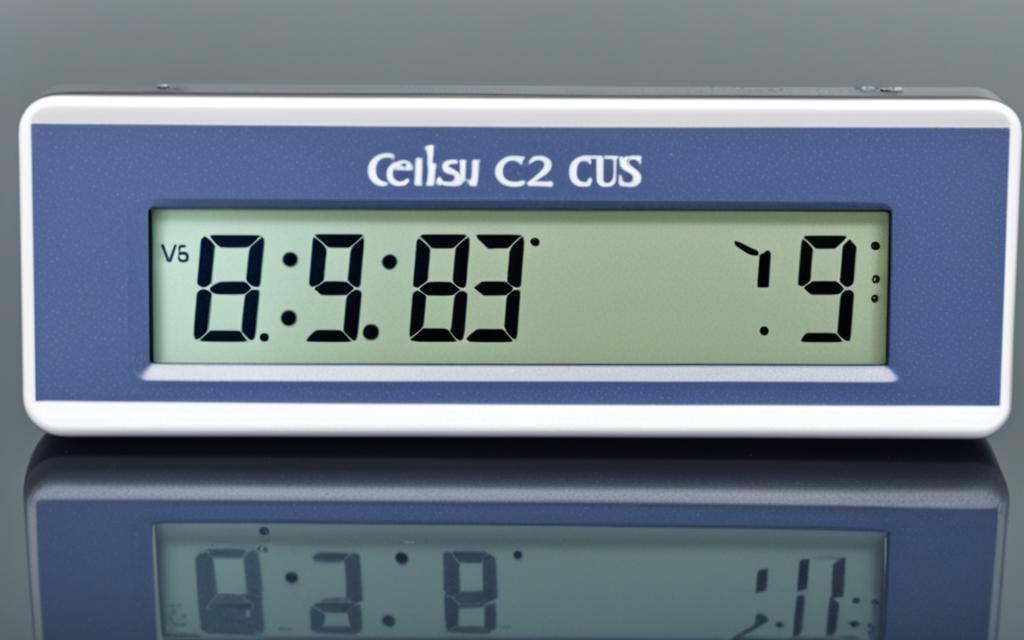Table of Contents
Knowing the right CPU temperature is key for your computer’s best performance. Most CPUs work well between 40°C and 80°C for usual tasks. When doing heavy work, they might heat up to 60°C to 90°C1. If the temperature goes over 80°C to 85°C, it might mean trouble. This is because CPUs like the AMD Ryzen 5000 series can handle up to 95°C without getting damaged1. But, letting them get hotter than 100°C often could harm them in the long run if they’re not cooled properly1.
So, it’s very important to keep an eye on how hot your CPU gets. This helps your computer run smoothly for longer.
Key Takeaways
- Normal CPU temperatures generally range from 40°C to 80°C.
- Under load, staying below 80°C is vital for optimal performance.
- Exceeding 85°C may indicate overheating and potential damage.
- Regular CPU heat monitoring ensures longevity and reliability.
- Different CPU models have specific temperature tolerances; know your specs.
Understanding CPU Temperature Basics
The temperature of your CPU is key to keeping your computer running well. It’s the heat your microprocessor makes while working. Knowing about CPU temperature helps keep your system steady and lasting longer.
What is CPU Temperature?
CPU temperature is shown in degrees Celsius. It tells us how warm the processor gets during tasks. At rest, it’s usually between 30 to 40°C. When busy, like when you’re gaming, it can shoot up to 60-85°C. If it gets hotter than 75°C during regular use, things start to get risky. It might even push to 80°C under lots of pressure2. The safety limit for most CPUs is about 95°C. They slow down at around 85°C to stop any harm3.
Why is CPU Temperature Important?
High CPU temperatures can cause trouble. Too much heat can make your system unstable, slow it down, or even damage it for good. Keeping the temperature down makes sure your computer runs smoothly and lasts longer. It’s best to keep the core under 60°C for big tasks like video editing2. Good cooling, airflow, and regular cleaning are vital3.
| Condition | CPU Idle Temperature (°C) | CPU Low Load Temperature (°C) | CPU Max Load Temperature (°C) |
|---|---|---|---|
| Ideal | 30-40 | Less than 70 | Less than 80 |
| Good | 40-65 | 70-80 | 80-85 |
| Risky | 65-75 | 80-85 | 85-90 |
| Dangerous | More than 75 | More than 85 | More than 90 |
Normal and Optimal Temperature Ranges for CPUs
Understanding normal and optimal temperature ranges is key for your CPU’s performance. Each CPU model has different specs that affect its temperature. It’s important to know these differences to keep your system working well.
Typical Ranges During Idle and Load States
When idle, CPU temperatures usually sit between 30°C and 50°C. Under heavy loads, they can jump to 70°C to 85°C45. CPUs like the Intel Core i9 might hit 100°C during hard tasks, with good cooling4. This shows CPUs tolerate heat well but cooling them improves performance and life.
Variations Based on CPU Models
CPU temperatures vary with the model. Newer Intel processors, from the 7th to 9th Generation, idle around 37-38°C and may reach about 60°C when busy6. Older models may run hotter but still within safe limits4. Correct cooling plays a big part in keeping temperatures in check, especially when the surroundings change5.
Keeping an eye on thermal limits helps stop overheating. CPUs have thermal caps, usually above 90°C4 and 100°C5. Good cooling systems help control heat, keeping performance up and hardware safe.
What is the Normal Temp for CPU
Knowing the normal CPU temperature norms is key for top device function. It’s advised to keep CPU temps under 60°C (140°F) for everyday tasks. While doing heavy jobs like gaming, it’s fine if the temp is between 70°C and 85°C (158°F to 185°F). But, going over 90°C (194°F) could cause damage that can’t be fixed7.
General Rules of Thumb
To keep your CPU healthy, watching temperature changes is important. Desktop CPUs should stay cooler than 130°F (54°C) when idle and below 175°F (79°C) under load8. For laptops, temperatures between 140°F (60°C) and 190°F (88°C) are seen as safe. This depends on the laptop and how much it’s being pushed.
Signs of Overheating
Spotting signs of CPU overheating can save your device. Common signs are sudden shutdowns, crashes, and slow performance. If your CPU often gets hotter than 85°C (185°F), it’s time to check your cooling system. You might need to clean vents or improve airflow78
How to Check and Monitor CPU Temperature
Keeping an eye on your CPU temperature is crucial for its performance and life span. You can use software or BIOS/UEFI settings to check it. Each method helps keep your system cool and avoids overheating.
Using Software Tools
There are many tools out there for tracking CPU temperature. For Windows, Core Temp is easy to use, showing current temperatures and workloads9. Mac users can try iStat Menus or Fanny for simple temperature monitoring9.
These applications can spot temperature rises during heavy use. When editing videos or gaming, CPU temps can go up to 149-176°F (65-80°C). Keeping an eye on these spikes is key to prevent performance drops10.
Checking Through BIOS/UEFI
Using BIOS/UEFI settings is another way to check CPU temp. Early in the boot process, it shows the temperature. Though effective, it doesn’t allow constant tracking. CPUs usually have a max temperature limit of 95°C to 105°C. Regular start-up checks help catch any thermal issues early on, keeping essential parts safe9.
| Method | Description | Platform |
|---|---|---|
| Core Temp | Easy-to-use software for real-time CPU temperature monitoring. | Windows |
| iStat Menus | Comprehensive monitoring tool for Mac users. | Mac |
| Fanny | Lightweight application for monitoring CPU temperatures on Mac. | Mac |
| BIOS/UEFI | Access firmware settings to view CPU temperature directly. | All platforms |
Methods to Maintain Optimal CPU Temperature
Keeping your CPU’s temperature right is key for top performance and a long life for your PC. There are good methods to keep your computer cool. These include making airflow better, cleaning regularly, and using better cooling solutions. These steps can cut down on overheating and make your parts last longer.
Improving Airflow and Ventilation
Better airflow is a top way to keep CPU temperature down. Tidy cables not only look good but help air move freely. Good quality case fans boost ventilation. Passive cooling, like smart case design, is a cheap way to keep temperatures ideal. Making sure parts aren’t too cramped also helps a lot with cooling.
Cleaning and Maintenance Tips
Cleaning out dust is key for cool CPU temperatures. Dust blocks air and makes temperatures go up. Using compressed air to clean parts keeps the cooling efficient. Set a schedule to check and clean your PC every few months. This makes sure fans work well and air flows freely.
Upgrading Cooling Solutions
If you want even better CPU cooling, consider upgrading. Switching to liquid cooling or high-end air coolers makes a big difference. These options are better at getting rid of heat, keeping CPU temperatures safe even when working hard. Keeping an eye on how your system performs with these coolers can prevent overheating and damage1112.
Conclusion
Keeping an eye on CPU temperature is key for the best performance and long life of your system. It should be between 30°C (86°F) and 40°C (104°F) for regular use. When gaming, it can go up to 75°C (167°F) to 80°C (176°F). If it goes over 80°C (176°F), you might have overheating problems that need quick action1314.
Managing your CPU’s temperature well prevents it from slowing down and crashing. It also makes your system more energy-efficient. This means your hardware stays in good shape for many years15.
To keep tabs on your CPU’s heat, use tools like BIOS or software like Core Temp and HWMonitor15. Having the right cooling setup and keeping your computer clean are vital. These steps help stop your CPU from getting too hot, which can harm your hardware and lower its performance13.
Knowing how to handle CPU heat is vital. It leads to a smoother operating computer. This protects important parts and increases your productivity.
FAQ
What is considered a normal CPU temperature?
A normal CPU temperature is usually between 40°C and 80°C under normal use. When you do heavy tasks, it can go up to between 60°C and 90°C.
How can I monitor the temperature of my CPU?
You can check your CPU temperature with programs like Core Temp, HWMonitor, and SpeedFan. You can also see it in the BIOS/UEFI settings when you start your computer.
What are the signs that my CPU might be overheating?
If your computer keeps crashing, shuts down by itself, or gets slower, it might be too hot. If it’s often over 85°C, you need to look at your cooling setup.
Are there specific temperature ranges for different CPU models?
Yes. Each CPU model handles heat differently. Most CPUs stay cool at 30°C to 50°C when idle. During usual activities, they can reach about 60°C. High-end CPUs might get as hot as near 100°C, but managing this heat is crucial.
What methods can I use to maintain optimal CPU temperature?
To keep your CPU cool, make sure there’s good airflow. This means tidying cables and cleaning fan dust. Considering better coolers, like liquid or efficient air types, helps a lot too.
Why is managing CPU temperature important?
Keeping the CPU cool matters because too much heat reduces its performance and might damage it. Good temperature control means your system works better and lasts longer.
Source Links
- https://www.tomshardware.com/how-to/how-to-check-cpu-temp-temperature – How to Check Your CPU Temperature
- https://www.makeuseof.com/tag/pc-operating-temperatures-hot-hot/ – PC Operating Temperatures: How Hot Is Too Hot?
- https://computercity.com/hardware/processors/normal-cpu-temperatures – Normal CPU Temperatures: Guidelines for Safe & Optimal Performance – ComputerCity
- https://community.spiceworks.com/t/what-is-a-normal-temperature-for-a-cpu-and-how-do-i-keep-it-low/948818 – What is a normal temperature for a CPU and how do I keep it low?
- https://www.avast.com/c-how-to-check-cpu-temperature – How to Check and Monitor Your CPU Temperature
- https://forums.tomshardware.com/threads/are-my-cpu-temperatures-normal.3437233/ – [SOLVED] – are my CPU temperatures normal?
- https://www.pandasecurity.com/en/mediacenter/how-to-check-cpu-temp/ – How to Check Your CPU Temperature – Panda Security
- https://www.businessinsider.com/guides/tech/what-is-a-good-cpu-temp – What is a good CPU temperature? How to make sure your computer isn’t overheating, and how to cool it down
- https://www.pcmag.com/how-to/how-to-monitor-your-cpu-temperature – cpu temperature monitor
- https://www.avg.com/en/signal/check-cpu-temperature – How to Check and Monitor CPU Temperature on Windows and Mac
- https://medium.com/@roywatson861/monitoring-and-maintaining-optimal-cpu-temperature-a-guide-to-checking-and-managing-your-7629f2b8d200 – Monitoring and Maintaining Optimal CPU Temperature: A Guide to Checking and Managing Your…
- https://gadgetmates.com/normal-cpu-gpu-temperatures-for-your-pc – Normal CPU & GPU Temperatures For Your PC – GadgetMates
- https://www.shiksha.com/online-courses/articles/all-about-cpu-temperature-range/ – CPU Temperature Range That Must Be Maintained – Shiksha Online
- https://www.lolvvv.com/blog/normal-cpu-temp-while-gaming – What is a Normal CPU Temp While Gaming?
- https://www.pugetsystems.com/labs/articles/impact-of-temperature-on-intel-cpu-performance-606/ – Impact of Temperature on Intel CPU Performance








